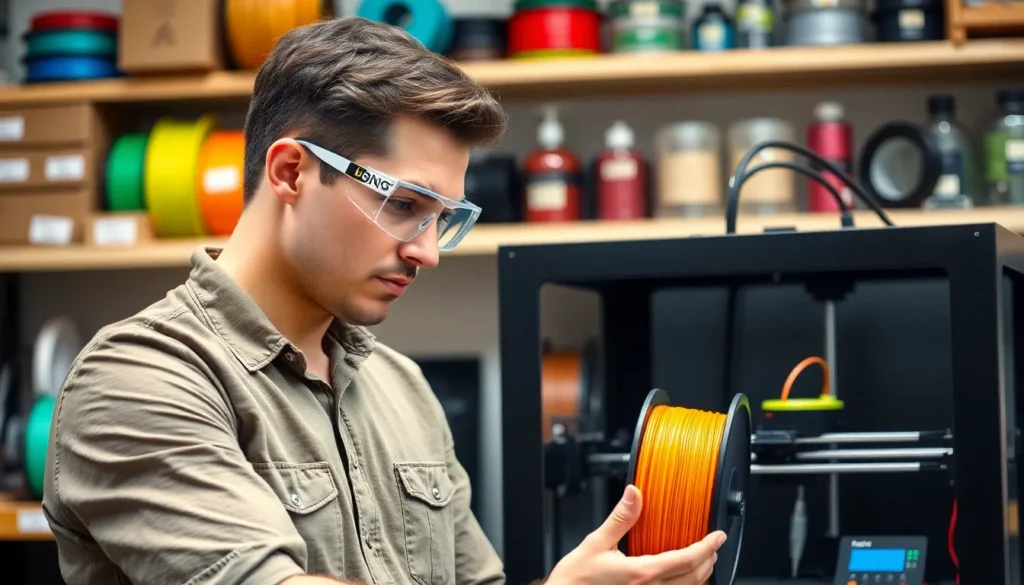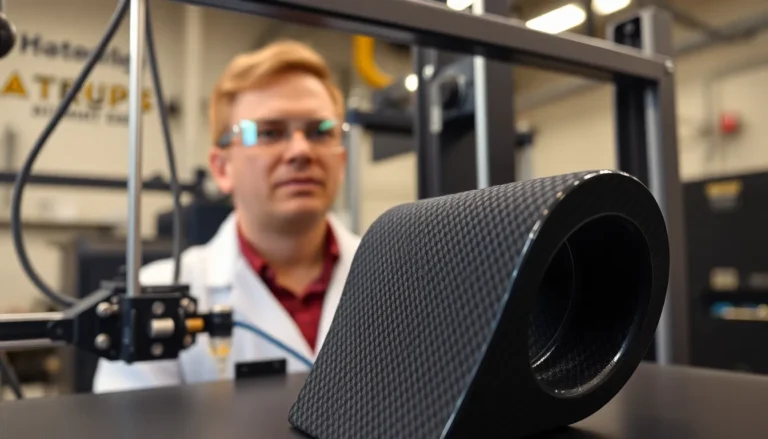Table of Contents
ToggleIn a world where creativity knows no bounds, 3D printing has become the magic wand for makers and innovators. But what happens when your filament runs low? Panic sets in, and suddenly, that brilliant design feels like a distant dream. Fear not! Finding quality 3D printing filament near you can transform that dream back into reality faster than you can say “extruder.”
Understanding 3D Printing Filament
3D printing filament is essential for creating projects and prototypes. Availability of various types of filament allows creators to select the material best suited for their needs.
Types of 3D Printing Filament
PLA is one of the most common filaments. It offers easy printing and biodegradability. ABS often provides greater durability and strength, making it ideal for robust applications. PETG combines flexibility and strength, offering resistance to chemicals. TPU stands for thermoplastic elastomer, which is perfect for flexible prints. Nylon enables strong, functional parts, generally used in more advanced projects.
Quality Considerations
Quality of filament significantly affects the final print. Look for reputable manufacturers and check for consistent diameters. Moisture content can lead to printing issues, so ensure proper storage. Color additives and additives can affect performance and aesthetics, influencing the choice of filament. Certifications offer insight into the material’s quality and safety; check for compliance with standards. Always consider user reviews to gauge overall satisfaction with the filament.
Finding 3D Printing Filament Near Me

Locating 3D printing filament nearby can streamline the creative process. Several options exist for acquiring quality materials.
Local Retailers
Local retailers often provide convenient access to 3D printing filament. Specialty stores dedicated to 3D printing usually stock various types like PLA, ABS, and PETG. Electronics stores frequently carry common filament brands, too. When shoppers visit these retailers, they can check product quality, diameter consistency, and moisture content firsthand. Some stores even offer samples for testing. For those living in urban areas, bigger craft and hobby shops often maintain a selection to support local makers.
Online Options
Online shopping offers extensive choices for 3D printing filament. Websites such as Amazon and MatterHackers feature extensive catalogs, including diverse materials like Nylon and TPU. Many suppliers provide user reviews that can guide purchasing decisions by sharing experiences from other customers. When buying online, it’s essential to verify filament specifications and check shipping times to avoid delays in projects. Some sellers offer discount bundles or promotional deals, providing opportunities for savings on bulk purchases.
Comparing Prices and Brands
Understanding 3D printing filament prices and brands is essential for making informed purchasing decisions. Many options exist, catering to various budgets and project requirements.
Budget-Friendly Choices
Affordable filaments such as PLA and PETG frequently provide excellent performance without breaking the bank. Brands like Hatchbox and Overture offer reliable budget options that maintain quality. Buyers often find 1-kilogram spools ranging from $20 to $30, making these choices accessible for casual users. Community feedback highlights the solid printing results achievable with these filaments. It’s beneficial to look for sales or bundle deals that further reduce costs, providing more value during purchases.
Premium Filament Options
For demanding projects, premium filaments, including Nylon and specialty materials like carbon fiber-infused options, deliver superior strength and flexibility. Established brands like Prusament and MatterHackers consistently produce high-quality filament. Prices for these premium spools generally start around $40 and can exceed $70, reflecting their advanced formulations. Users report improved print quality, durability, and resistance to warping, making them worthwhile investments. Researching material properties ensures a suitable choice for intricate prints or functional prototypes.
Tips for Choosing the Right Filament
Selecting the ideal filament impacts printed project quality. Understanding printing techniques and material properties is essential.
Printing Techniques and Materials
Different printing techniques require specific filament types. Fused Deposition Modeling (FDM) commonly uses PLA and ABS for optimal flow. Stereolithography (SLA) requires resin compatible with photopolymerization. Select materials suitable for your technique to ensure accurate layers and structure. Conduct research on properties like strength, flexibility and temperature resistance to match project requirements. Some materials deliver superior detail, while others emphasize durability. In applications demanding detail, choose filaments like PETG or TPU. For functional prototypes, stronger materials like Nylon provide enhanced performance.
Compatibility with Your 3D Printer
Compatibility between filament and 3D printer model is crucial. Consult the printer’s specifications to verify supported filament types. Many printers excel with standard filaments like PLA and ABS, while others require advanced materials. Utilize manufacturers’ guidelines to assess nozzle temperature and settings for optimal printing conditions. Consider extruder design as some require specific filament diameters, such as 1.75 mm or 2.85 mm. Assess user reviews for hands-on experience with various filament types and specific printers. Ensuring filament compatibility promotes successful prints and enhances overall results.
Finding quality 3D printing filament nearby can significantly enhance the creative process. Whether opting for local retailers or exploring online options, the right filament can make all the difference in project success. By considering factors such as material properties and printer compatibility, creators can ensure their designs come to life with precision and durability.
Investing time in research and selecting reputable brands will lead to better outcomes in 3D printing. With the right resources at hand, anyone can turn their innovative ideas into tangible creations without the frustration of running low on filament.




